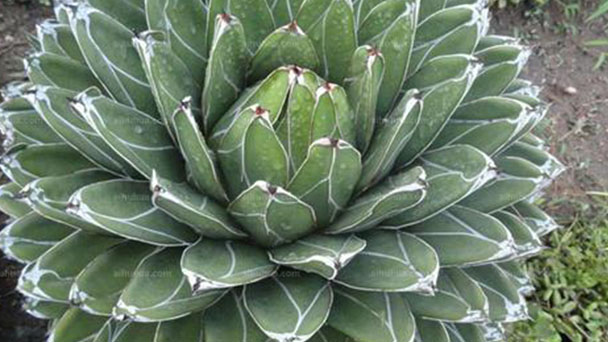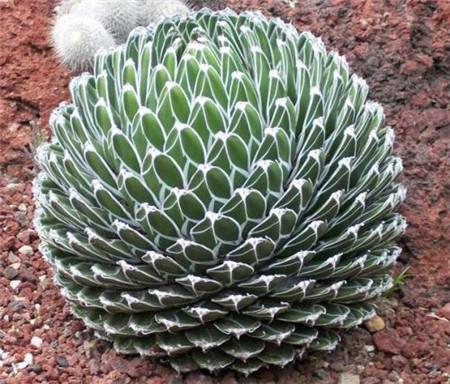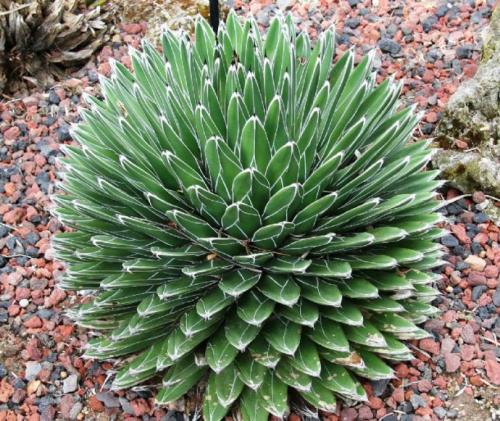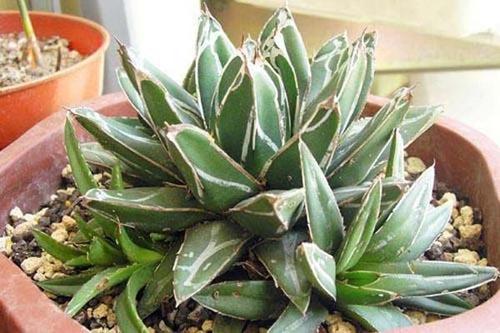Agave victoriae-reginae (Queen Victoria agave) profile
Written by Maggie
Mar 24 2021

Queen Victoria agave, scientific name Agave victoriae-reginae, is a plant of the genus Aguila. Queen Victoria agave can be grown at home or set up in a desert landscape.
Queen Victoria agave picture

Morphological characteristics of Queen Victoria Agive
Queen Victoria Agive is a fleshy herb. Plants has no stems, fleshy leaves are arranged in rosettes, plant length up to 40 cm; Large Queen victoria agave is up to more than 100 leaves, leaves triangular cone, 10 ~ 15 cm long, about 5 cm wide, apex thin, flat ventral, back round slightly keel-like convex; The leaves are green, with irregular white lines, white keratin on the edge of the leaves and the keel on the back of the leaves, and 0.3 ~ 0.5 cm hard black spines on the tip of the leaves. The queen victoria agave grows for about 30 years before flowering. Loose spikes are up to 4 m high. The florets are pale green and about 5 cm long. After the flower seeds, the plant will wither and die.
The ecological habits of Queen Victoria Agive
Queen Victoria Agive has a strong character. Queen Victoria agave likes full sunshine, warm and dry environment, and is resistant to drought, semi-shade and cold. Queen Victoria agave is afraid of waterlogging.
How to grow and care for Queen Victoria agave
Light and Temperature
Queen Victoria agave should be given sufficient illumination in the growing period. Queen Victoria agave can be maintained outdoors in full sunshine, outside the south-facing balcony, on the roof and other sunny places. Queen Victoria agave can also grow in semi-shade, but due to insufficient illumination in the cultivation environment, leaves will grow barren and white lines on the leaves will not be obvious. Pay attention to ventilation and cooling in summer high temperature, appropriate shading, avoid hot sun exposure, so as not to burn the leaves caused by high temperature or strong light. In addition, Queen Victoria agave that have been kept in poor light for a long time and suddenly exposed to the sun can also cause foliar burns.
Watering
In the growing season, Queen Victoria agave should be watered "if not watered, then watered thoroughly", so as to avoid long-term water retention in the basin soil, otherwise it will rot the roots. When the air is too dry, some water can be sprayed on the plants to keep the leaves clean, increase the air humidity and make the leaves moist. But also can not be long-term drought, otherwise the plant growth stagnation, withered leaves wrinkle, plant lack of vitality, seriously affect the ornamental.
Double pot with soil
The young plants of Queen Victoria Agive are potted once a year, and the mature plants are potted once every 2 to 3 years, generally in spring. The potted soil should be loose and fertile, with good drainage and air permeability, and contains an appropriate amount of calcareous and sandy soil. The calcareous materials such as garden soil, leaf rot soil, coarse sand, bone meal and shell powder are commonly mixed and prepared. If conditions are available, it is best to plant with coarse red jade soil, fairy soil and other materials, in order to increase the drainage permeability of the soil, to prevent root damage. Flower pot should be large, for small seedlings, countable plants planted in one pot, to facilitate management.
Environmental humidity
Queen Victoria agave is cultivated in an environment where the air humidity is too low, and the leaves are often sprayed with water with too low temperature, which will cause dark spots on the leaves. Leaf burns caused by too strong sunlight and too high temperature will also cause leaf damage. Winter in the room with sufficient light, control watering, stop fertilization, 0℃ above can be safe over the winter.
Fertilization
Apply decayed thin liquid or compound fertilizer every 10 days or so.

Queen Victoria agave propagation
The propagation of Queen Victoria agave is mainly based on plant division, which is usually carried out in combination with pot changing in spring, and can also be carried out in the growing season. The method is to take off the seedlings germinating at the base of old Queen Victoria agave, put them into pot plants directly if they have roots, hang them for 3-5 days if they have no roots, and put them into pot after the wounds are dried. They are easy to survive. Queen Victoria agave can also be sown in spring, and the soil should be sterilized at high temperature. After sowing, the seeds germinate for 2 ~ 3 weeks under the condition of 20 ~ 25℃. When the seeds grow out of 2 ~ 3 pieces of true leaves, the seedlings are transplanted.
Disease control of Queen Victoria agave
After planting for a period of time, Queen Victoria agave found some irregular black spots on the leaves of Queen Victoria agave, and some withered leaf tips, which should be dealt with in time.
Specific methods:
Sometimes the leaf tips of Queen Victoria agave will wither, and black spots of irregular shape will appear on the leaf surface. The reason is that the roots grow too full in the pot, and too many fine buds from the rhizomes, so the water cannot penetrate into the soil. Therefore, this requires us to observe frequently in the maintenance process at ordinary times, turn over the basin regularly, so that the soil is loose and ventilated, the root system grows well, and timely breaks off the excessive fine buds at the base. In addition, when the humidity in the air is too low, it will also cause foliar dark spots. Queen Victoria agave generally grows slowly, so you can use less fertilizer and not too much water in the maintenance process. Queen Victoria agave should be maintained in a place without direct sunlight, and it is better to plant with coarse-grained red jade soil or fairy soil.
The distribution area of Queen Victoria agave
Queen Victoria agave is distributed in desert areas and temperate desert areas (major cities: Urumqi, Shihezi, Karamay, Hami Kashgar, Wuwei, Jiuquan, Yumen, Jiayuguan, Golmud, Korla, Jinchang, Wuhai).
Garden use of Queen Victoria agave
Queen Victoria agave is one of the most attractive succulent plants with beautiful plant shape and hard leaves, although it does not have gorgeous flowers. Queen Victoria agave brocade and Queen Victoria agave brocade are rare and precious varieties with sharp contrast in leaf color, which are suitable for lovers to collect and cultivate. Queen Victoria agave and Queen Maruba Victoria Agive are small and lovely in shape. They decorate balconies, windowsills, several cases and other places with fresh and elegant taste and endless fun.

Latest Updated
- Benefits of Bugleweed - 7 Science-backed Health Benefits
- Bugleweed Dangers & Side Effects - Is It Poisonous?
- How to Plant Evergreen Trees - What You Should Know
- When to Plant Evergreens - Grow Guide for Evergreen Trees
- 12 Wonderful Evergreen Shrubs for Your Garden
- 12 Popular Evergreen Plants with Pictures for Beginners
- When And How To Prune A Lilac Bush Like a Pro
- How to Grow & Care for Lilac Vine (Hardenbergia Violacea)
- Japanese Lilac Tree (Syringa Reticulata) Care & Propagation Guide
- Shumard Oak Pros and Cons - What to Know
Popular Articles
- Winter maintenance of Antirrhinum Majus
- How to Grow Terminalia Mantaly Tree
- How to Grow and Care for Crossostephium Chinense
- How to grow Antirrhinum Majus in spring
- Peristeria Elata (Dove Orchid) Profile: Info & Care Guide
- Underwatered Snake Plant (Sansevieria Trifasciata) - Signs And How To Fix
- How to Care for Brazilian Jasmine Plant (Mandevilla Sanderi)
- How to Grow & Care for Graptopetalum Purple Delight in Summer
- Rosa Chinensis (China Rose): Plant Growing & Care Tips
- How to Care for Baby Sun Rose (Aptenia Cordifolia)